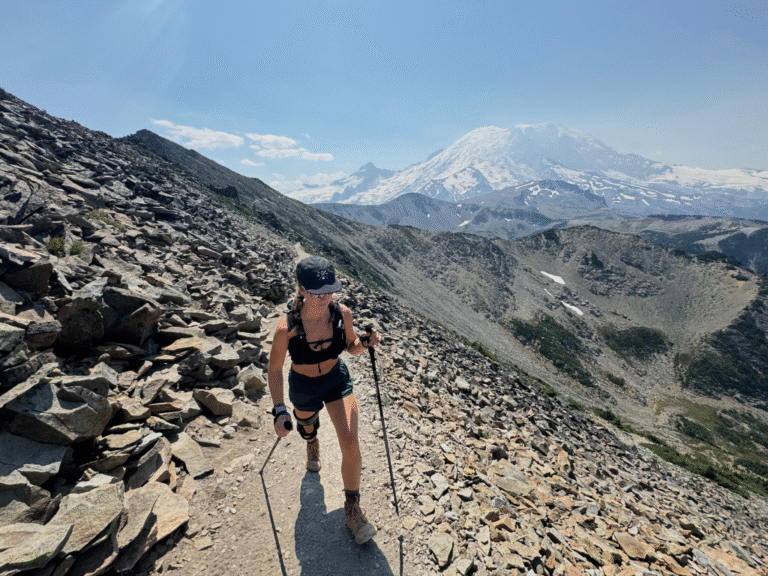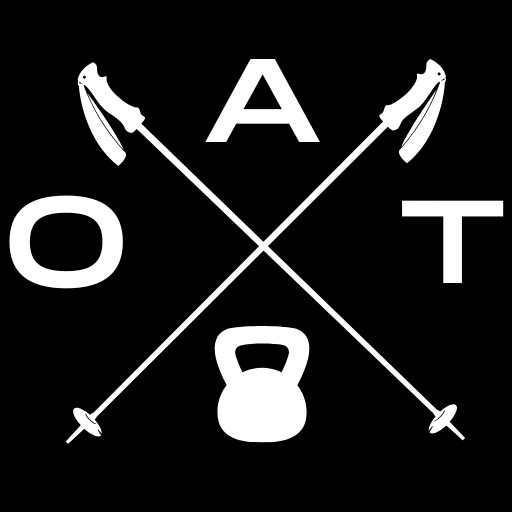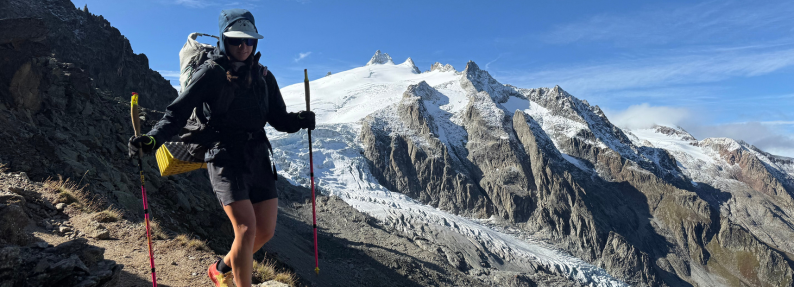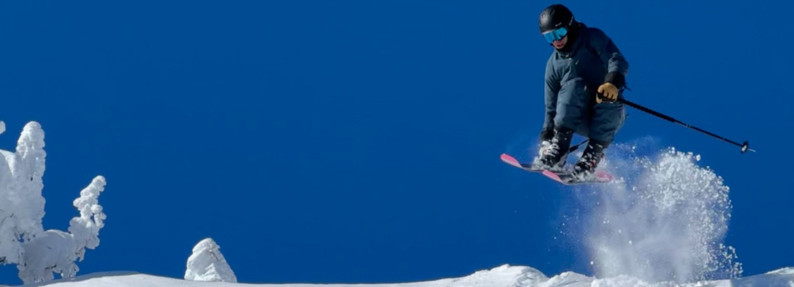Surgery to Summit
From Surgery TO Summit
A one-year journey through ACL recovery, rehabilitation, and a return to the mountains.
I breathe in the crisp, high-alpine air as I set the skin track, weaving uphill through soft, untouched snow. The hut we slept in the night before fades behind me. My skis glide in quiet rhythm, carving a steady path toward the col. Visibility begins to clear, my breath slow, controlled. Everything feels still and electric all at once.
As my eyes meet the ridgeline ahead, I’m pulled back to a year ago, lying under sterile hospital lights, moments before surgery, one thought echoing in my mind: I will never be the same again.
And now, I know—that couldn’t be more true.
a Dual Loss
Three weeks after my father passed away, I tore my ACL while skiing in the backcountry.
At the time, I was pushing hard in the mountains, not just training, but escaping. Movement was my way of coping. I believed that if I just kept going, if I skied farther, climbed higher, stayed in motion, I could outrun the grief that trailed quietly behind me.
But the injury stopped me cold. For the first time, I was forced into stillness. The grief I thought I could outpace in the skin track gave way beneath me, and I was caught in an avalanche of emotion, swept off my feet.
Grief for my dad. Grief for the loss of my athletic identity. And the humbling realization that I was at the beginning of a long road of recovery.
I went from feeling the strongest I ever had in the mountains to needing help with even the smallest tasks, getting off the couch, into bed, into the shower.
The outdoors had always been my place of strength, expression, and restoration. Suddenly, I found myself staring down two grieving processes at once: the emotional trauma of losing my father, and the physical and psychological trauma of losing movement, losing a part of myself.

Scrambling toward the summit of Mt. Thielsen, pre-injury.
Channeling my inner mountain goat on a ridgeline in Northern California.
I will never be the same
The morning of surgery, I lie on a narrow hospital bed, cocooned in thin, starchy sheets. The room hums with fluorescent light and anticipation. One thought pulses through my mind on repeat: I’ll never be the same.
It was a thought I had internalized, from what I’d been told, from what I’d seen, from the narratives around recovery. I feared I might never trust my knee again. That I’d live with chronic pain. That the version of me who moved through the mountains with strength, fluidity, and ease, was gone.
That statement ended up being true. I would never be the same as I was before my injury. But not in the way I feared. That truth didn’t mark the end of who I was, it marked the beginning of who I would become.

Fresh out of surgery, still foggy from anesthesia.

Right: Taking my first steps one day post-op.
Taking Ownership Of Recovery
I didn’t have a dream team of rehab specialists. I didn’t have a state-of-the-art facility or insurance that covered high-level sports recovery. What I had was a BOSU ball, a yoga mat, and a deep well of stubborn determination.
The PT resources available to me weren’t designed to help someone return to skiing in the backcountry. They were focused on getting people back to walking, sitting, driving, not gliding across glaciers with 40 pounds on your back. I knew I needed more than that. I knew if I wanted to come back strong, not just functional, I’d have to take matters into my own hands.
So I did.
I leaned on the expertise of my surgeon, who had worked with the U.S. Ski Team. He pointed me toward peer-reviewed studies, and I devoured them. I broke the research into weekly rehab phases, building spreadsheets, drafting protocols, and designing progressions tailored to what I needed. My goal wasn’t just to heal. I wanted to return to the mountains with a new baseline.
There was no yellow brick road. No promise that if I did X, Y, and Z, I’d be good to go. No clear-cut plan, no milestone map taped to the wall, no one telling me exactly when I’d feel like myself again.
There was a lot of uncertainty. A lot of feeling lost. A lot of wondering if I was doing enough, or if I was doing too much.
But there was also something else: A quiet sense of empowerment.
I realized I had the capacity to learn. To be curious. To explore the process rather than fear it.
I dove into the research. I looked at best practices that were backed by science, and began weaving what I learned into my own programming, shaping a path forward based on what I needed, not just what was standard.
That mindset, of curiosity, of agency, became the foundation of my recovery. And over time, that foundation became stronger than I ever expected.

Early stages of recovery, relearning foundational movement patterns.

Rebuilding neural pathways through creative training in the gym.
Redefining Movement, Rebuilding Meaning
Movement became a practice of presence. It was how I processed. How I stayed connected to my body during grief. How I reminded myself that progress didn’t have to be loud, fast, or impressive. It just had to be honest and consistent.
The physical healing unfolded right alongside the emotional. As I rebuilt strength and stability in my knee, I found myself returning to an inner strength as well, one shaped by stillness, patience, and the willingness to meet myself exactly where I was.
I reflected deeply on my relationship with my dad, on all the ways we show up, and fall short, for the people we love. On how we speak to each other, and how we speak to ourselves in times of frustration and hardship.
Eventually, the outdoors returned too. But they looked different.
I moved more slowly. More intentionally. And I felt an immense sense of gratitude just to be out there again. The simple ability to explore felt like a privilege I had never fully understood until I lost it.
The mountains became a place of deep reverence.
They didn’t care how fast I was. They didn’t care if I wore a leg brace. They held space for grief, for joy, for authenticity.
And somewhere in that space, I realized I wanted to help others navigate this too.
Designing my own rehabilitation program planted the first seed. It made me curious. It gave me a sense of purpose. That curiosity eventually led me to pursue my personal training certification, and without realizing it at the time, laid the foundation for what would become the KneeHab Program, a space for others navigating injury, grief, uncertainty, and the slow, steady process of returning to the things they love in the outdoors.

Progressive strength training paired with targeted proprioceptive exercises.

Putting it to the test out on the trail!
Full circle: a return to the skin track
In the final weeks of my one-year recovery, I moved through glaciated, complex terrain, carrying over a third of my body weight in the form of a fully loaded pack with all the gear necessary for three-day expeditions in the remote Coast Mountains of British Columbia.
I completed both the Garibaldi Neve and Spearhead ski traverses. These iconic routes are known for their high-alpine, exposed, glaciated terrain. They require not just fitness, but focus, adaptability, and the ability to move with confidence through constantly changing conditions.
The physical demands were real. But what required even more was mental resilience: stepping into terrain with uncertainty, not knowing how my knee would respond to the weight, the duration, or the effort required.
I had fears. Fears around re-injury. Fears around whether I was truly ready. Fears around what risk meant to me now.
But those fears were met with something else: presence, fortitude, and trust.
Each step on the skin track served as a mirror, reflecting the depth of the work I had put in over the past year. Every stride was a confirmation that the hours, the setbacks, the small victories, and the daily decisions to keep showing up had cultivated a deep-rooted ability to endure.
To make a turn onto my ACL-repaired knee required a level of trust I had to earn again and again. It wasn’t just about strength or balance. It was about breaking through a different kind of scar tissue—not the kind you can see, stretch, or mobilize, but the kind that forms quietly in the mind after injury, made of fear, self-doubt, and hesitation.
Each turn was a test. Each descent asked me to commit, not just to my knee, but to myself. To believe I could do it. To trust that I was capable.
That’s the part of recovery we don’t talk about enough: the psychological scar tissue. The kind you work through not with reps or sets, but with patience, awareness, and the willingness to move through fear rather than away from it.
And maybe that’s what recovery really is: not just returning to how things were, but relearning how to begin again and show up in the face of uncertainty.

Scouting the route across Overlord Mountain on the Spearhead Traverse.

Navigating glaciers with a 40-pound pack.
An invitation to begin again
This is my story. I’m not a professional athlete. I didn’t have access to elite facilities, high-performance rehab teams, or cutting-edge equipment. What I did have was a deep desire to return to the things I love, and a willingness to do the work with what I had.
Everyone’s recovery will look different. There’s no universal path and no single definition of success. Healing is not linear. Grieving what was is part of the process. But so is choosing what comes next.
If you’re facing injury, uncertainty, or the loss of movement that once defined you, I hope this reminds you: you are not alone. The fear that you won’t return to the things you love is real, but so is the opportunity to begin again.
And with that opportunity comes something powerful: the chance to reset your foundation, to rebuild with intention, and to reclaim your relationship with your body and the outdoors on your own terms.
You don’t have to go back to who you were. You can begin again, right where you are. And you can choose to come back more grounded, more connected, and more capable than ever before.

Soaking in the panoramic views of British Columbia’s Coast Range.

Five days before my one-year post-op mark, about to ski across the McBeth Glacier on the Spearhead Traverse.
Kneehab Program
8-week knee rehabilitation and strengthening program designed for outdoor enthusiasts recovering from injury or looking to improve knee stability. This program focuses on building strength, mobility, and neuromuscular control to help you get back to the activities you love, whether it’s hiking, skiing, or running.
Why Choose KneeHab?
KneeHab is an 8-week rehabilitation program designed to enhance knee strength, mobility, and stability—so you can confidently return to your outdoor pursuits. Whether you’re returning to sport after knee surgery, rehabbing a past injury, or dealing with ongoing knee pain, this science-based program is crafted to reduce re-injury risk and optimize knee health. Through specialized exercises that improve neuromuscular efficiency and build strength, KneeHab prepares you to return to the activities you love with stronger, more resilient knees!
Benefits & Results
- Science-Based Training for real results
- Build muscular strength & Knee stability
- Reduce risk of re-injury
- Boost Low-Impact Cardio Endurance
- Enhance Knee Mobility & Range of Motion
Program Structure
- 1:1 Trainer Support
- 3 KneeHab workouts per week
- 2 Cardio Workouts Per Week
- 35-60 minute workouts
- Self-Paced & Flexible Schedule
- Daily Mobility Routines





7-Day Free Trial
Try the KneeHab program risk-free for a week. Experience customized workouts and support that will get your knee ready for any adventure.
PROGRAM STARTS EVERY MONDAY
Monthly
- Training Program on OAT's App
- Daily Knee-Focused Programming
- 1:1 Messaging With Your Trainer
- Progress Tracking & Analytics
- Community Support & Challenges
- Full Access to OAT's Member Resources
8-Week
- Training Program on OAT's App
- Daily Knee-Focused Programming
- 1:1 Messaging With Your Trainer
- Progress Tracking & Analytics
- Community Support & Challenges
- Full Access to OAT's Member Resources
Have Questions?
We understand that starting a training program is a commitment you’re making, and we want to ensure that you get the most out of your experience with us. Ahead of registering for any of our programs, we’re available for a free 30-minute consultation to address any questions you may have.






